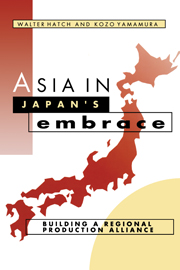Book contents
- Frontmatter
- Contents
- List of Tables
- List of Figures
- Preface
- Part One Co-Prosperity Again
- Part Two The Embracer and the Embraced
- Part Three A Japanese Alliance in Asia
- 7 The Visible Handshake
- 8 Vertical Veins of Humanity
- 9 The Labor Network
- 10 The Supply Network
- Part Four A Powerful Embrace
- Notes
- Select Bibliography
- Index
8 - Vertical Veins of Humanity
Published online by Cambridge University Press: 05 February 2012
- Frontmatter
- Contents
- List of Tables
- List of Figures
- Preface
- Part One Co-Prosperity Again
- Part Two The Embracer and the Embraced
- Part Three A Japanese Alliance in Asia
- 7 The Visible Handshake
- 8 Vertical Veins of Humanity
- 9 The Labor Network
- 10 The Supply Network
- Part Four A Powerful Embrace
- Notes
- Select Bibliography
- Index
Summary
Having just completed an interview, we gathered our belongings, paid our respects, and stood up to leave the foreign ministry of Thailand. Just then, however, a young aide rushed breathlessly into the room, closed the door behind him, and asked us to wait a minute so that a “very important person” could traverse the hallway quietly, board the elevator quickly, and leave the building undisturbed. We glanced at one another with the same quizzical look. Who could it be? The king himself? No. The VIP, it turned out, was Japan's ambassador, making one of his many house calls to political clients in the Thai bureaucracy.
We should not have been so surprised. “Gone are the days when statements or interviews given by the Bangkok-based envoys of the U.S. or other Western countries would automatically make headlines. Now it is the Japanese envoy,” observes a Thai journalist. “His remarks about Japan's financial assistance and future plans for Thailand make the news.”
Indeed, Japan now enjoys enormous political clout throughout Asia. Economic policy for Thailand, Malaysia, Indonesia, the Philippines, and other nations in the region is often reshaped, if not formed out of the void, in Tokyo.
This fact is more than marginally related to the amount of official development assistance (ODA) that Japan provides. In 1993, it contributed $4.9 billion to Asia – nearly three times more than it gave to countries in Africa and Latin America combined.
- Type
- Chapter
- Information
- Asia in Japan's EmbraceBuilding a Regional Production Alliance, pp. 130 - 145Publisher: Cambridge University PressPrint publication year: 1996



